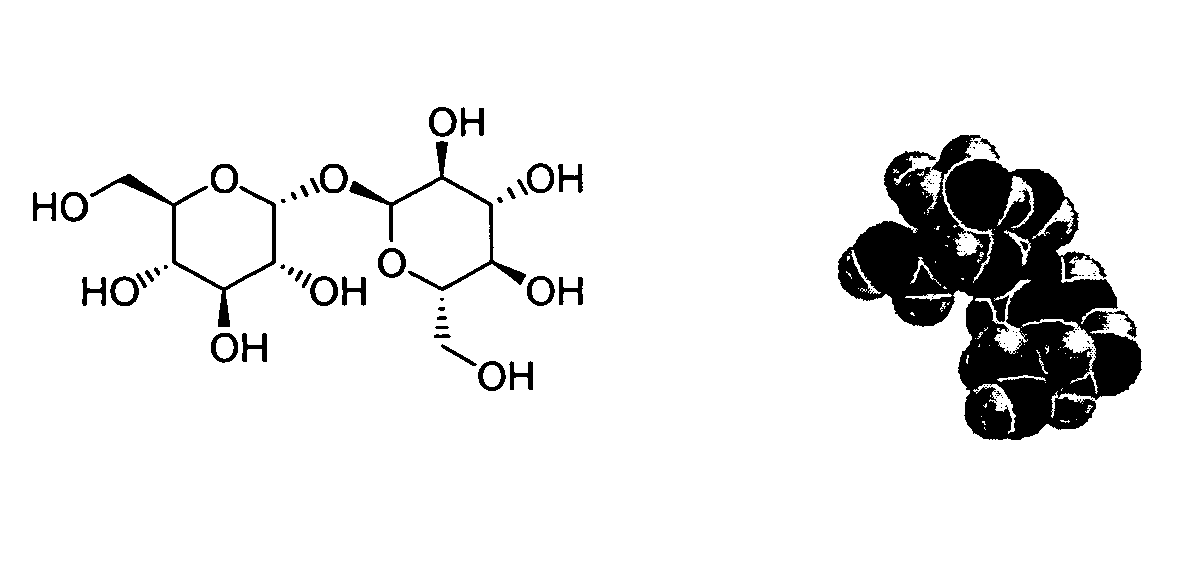Heat-stable enzyme compositions
a technology of enzyme composition and heat stability, which is applied in the direction of enzyme stabilisation, enzymes, biochemistry apparatus and processes, etc., can solve the problems of loss of activity during various processing conditions, variability of enzymes, and loss of activity during storage, so as to enhance the thermal stability of enzymes
- Summary
- Abstract
- Description
- Claims
- Application Information
AI Technical Summary
Benefits of technology
Problems solved by technology
Method used
Image
Examples
example 1
General Procedure for the Preparation of an Enzyme / Trehalose Syrup
[0036]A total of 20 g trehalose dihydrate was dissolved in a beaker containing 20 g of in water that had been filtered using a Millipore Milli-Q® water purification system. The water was previously heated to in between 50 and 100° C. in order to accelerate dissolving. The beaker was tared and then heated on a heating plate equipped with a magnetic stirrer. The heater was set at 200° C. and the water evaporated, while the mixture was gently stirred. The amount of water evaporated was checked by weighing. When 95-97.5% of the water was evaporated the heating was stopped and 20 g of the commercial enzyme Neutrase® 0.8 L (Novozymes, Denmark) was slowly added to the trehalose syrup while stirring. Typically the temperature of the solution will drop from ˜99° C. to ˜65° C. The mixture was cooled down in a cold-water bath to achieve a mixture temperature below 35° C. The enzyme / trehalose syrup was then ready for further use ...
example 2
General Procedure for the Preparation of an Enzyme Encapsulated in Trehalose by Spray-Drying
[0037]In a beaker, 50 g of water that had been filtered using a Millipore Milli-Q® water purification system was heated to 100° C. and 50 g of trehalose was added while stirring. No further heating was required. When the trehalose was dissolved, 6 g the enzyme mixture used in Example 1 was added. Also free flowing agents, such as vermiculite, silica, cyclodextrin, maltodextrin, gelatin, cornstarch, sepiolite and cellulose, can be added to the mixture. The liquid was spray dried using parameters that yield a dry free flowing powder These parameters include adjusting spray drying inlet and outlet temperatures and / or the addition of other amounts of the free flowing agent.
example 3
General Procedure for the Steam Challenge Experiment
[0038]A Büchi distillation unit B342, typically used for Kjeldahl analysis was used as a steam generator for the steam challenge experiment. The outlet of the steam generation tube was connected with a rubber tube to the side neck of a double-necked flask. A glass Büchner filter was connected to the vertical neck of the flask by means of a rubber stopper. All elements were securely fastened with clamps because over-pressure is generated during the experiment. The steam produced by the distillation unit will enter the flask and the steam will partially condensate. The remaining vapors will mount through the vertical neck into the Büchner filter which is filled with a control matrix or an enzyme treated matrix. A homogeneous steam treatment is obtained by continuous stirring of the matrix.
[0039]A quantity of 1000 g of a typical broiler feed was supplemented with the enzyme to be tested at a dose rate of 1 kg / tonne. The feed was homog...
PUM
| Property | Measurement | Unit |
|---|---|---|
| temperature | aaaaa | aaaaa |
| temperature | aaaaa | aaaaa |
| temperature | aaaaa | aaaaa |
Abstract
Description
Claims
Application Information
 Login to View More
Login to View More - R&D
- Intellectual Property
- Life Sciences
- Materials
- Tech Scout
- Unparalleled Data Quality
- Higher Quality Content
- 60% Fewer Hallucinations
Browse by: Latest US Patents, China's latest patents, Technical Efficacy Thesaurus, Application Domain, Technology Topic, Popular Technical Reports.
© 2025 PatSnap. All rights reserved.Legal|Privacy policy|Modern Slavery Act Transparency Statement|Sitemap|About US| Contact US: help@patsnap.com

